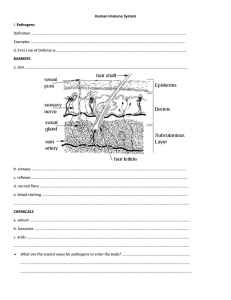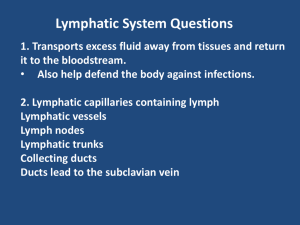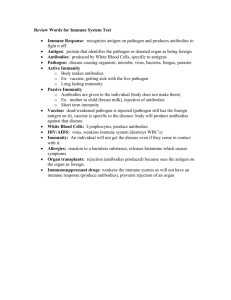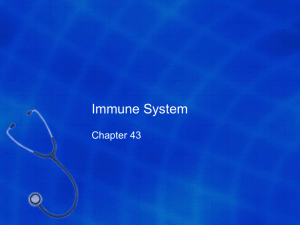8.3 - misskaleyhanson
advertisement
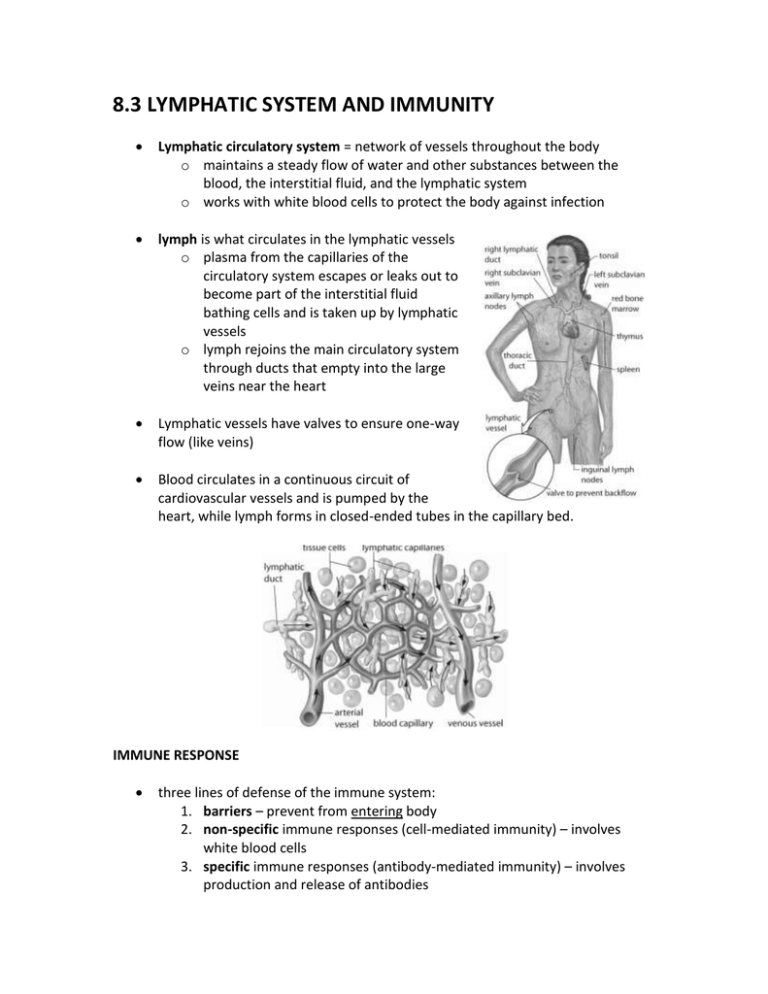
8.3 LYMPHATIC SYSTEM AND IMMUNITY Lymphatic circulatory system = network of vessels throughout the body o maintains a steady flow of water and other substances between the blood, the interstitial fluid, and the lymphatic system o works with white blood cells to protect the body against infection lymph is what circulates in the lymphatic vessels o plasma from the capillaries of the circulatory system escapes or leaks out to become part of the interstitial fluid bathing cells and is taken up by lymphatic vessels o lymph rejoins the main circulatory system through ducts that empty into the large veins near the heart Lymphatic vessels have valves to ensure one-way flow (like veins) Blood circulates in a continuous circuit of cardiovascular vessels and is pumped by the heart, while lymph forms in closed-ended tubes in the capillary bed. IMMUNE RESPONSE three lines of defense of the immune system: 1. barriers – prevent from entering body 2. non-specific immune responses (cell-mediated immunity) – involves white blood cells 3. specific immune responses (antibody-mediated immunity) – involves production and release of antibodies 1. Barriers Barrier Chemical or Physical How it works Eyelashes physical trigger reflex blinking may catch airborne particles contain antibodies and lysozyme (antibacterial enzyme) Tears Cilia of the respiratory tract chemical physical cilia sweep dust, bacteria, and other airborne particles towards the mouth, preventing them from entering lower respiratory tract Stomach acid chemical kills pathogens Skin chemical and physical Bactericides in skin make it inhospitable for microbes to grow; perspiration acidic outer layer made of keratin which is waterproof and indigestible 2. Non-Specific Immune Response (Cell-Mediated) includes the white blood cells: lymphocytes, macrophages, Killer T cells (cytotoxic T cells) and other T cells white bloods cells find and destroy pathogens (bacteria, viruses, cancer) through the process of phagocytosis = engulf and digest pathogen engulfing and digestion of a pathogen leads to antibody-mediated immunity 3. Specific Immune Response (Antibody-Mediated) Cells produce antibodies = proteins that can recognize specific foreign substances the body and neutralize and destroy them Include the lymphocytes (white blood cells) made in the thymus gland (T cells – mission is to seek out intruder and signal B Cells to attack) and in the bone marrow (B cells – mission is to produce antibodies) *** note T cells also in Cellular-Mediated Immunity ****** Antibodies are proteins that recognize antigens (identifier molecules that are found on the surface of all cells) on foreign substances Antibodies bind with antigens to produce an antigen-antibody complex which is larger and more easily identified so it can be engulfed by macrophages Once body recognizes foreign antigens it builds up immunity after each exposure due to specialized memory cells that recognize another encounter with the foreign antigen More antibodies produced after second exposure It took less time to produce antibodies in second exposure HOW THE SECOND AND THIRD LINE OF DEFENSE WORKS: Pathogen (with antigen marker) enters body and is engulfed by macrophage Macrophage displays antigen marker on cell surface stimulates Helper T cells bind to macrophage and release chemical that activates other T cells and B cells Killer T Cells (cytoxic T cells) puncture cell membranes of pathogen Stimulates production of Memory T Cells to recognize more pathogens Stimulates production of more active Killer T Cells and suppressor T cells (inhibit immune so normal tissues not destroyed Activated B cells enlarge and produce memory B cells and plasma cells Plasma cells produce more antibodies Memory B cells remain in blood for next exposure Antibodies bind with antigens (antigen-antibody complex) and are recognized and destroyed by macrophages

